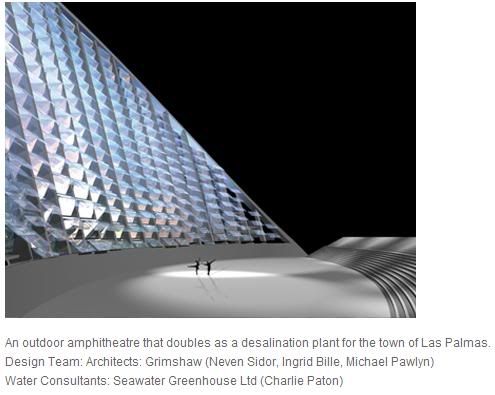The Las Palmas Water Theatre ( Teatro del Agua )
( Conventional desalination and water purification plants and process may become history.)

The Teatro del Agua, together with the proposed new waterfront buildings, utilise energy ONLY from the sun, the sea and the atmosphere to create cooling and fresh water. The process is based on the Seawater Greenhouse concept.
The proposed development covers an area of about 400 000 m2. In the sunny climate of the Canary Islands, will produce 300 million liters of fresh water a day.
The “Water Theater” is being planned for the Canary Islands which will not only be a seaside cultural center for performing arts, but will also serve as an innovative desalination plant. The architecture of the sea-facing wall is such that cool sea water is pumped into tubes then sprayed on a membrane through which sun-warmed air flows. The warm air over the cooler tubes causes the condensation of fresh water which drips into collecting drains below. This is essentially a giant solar convection powered dehumidifier that should be able to provide enough fresh water for an entire city! It also combines aesthetic architecture with renewable resource management and doubles as a theater that benefits the entire community.
This is a relatively new development, requiring the use of low cost plastics for pipes, pumps and heat exchangers (metals that are adequately corrosion resistant to seawater are generally too expensive for such applications).
Gran Canaria has abundant sunshine year round yet with moderate temperatures for its latitude (which is the same as Kuwait). It also lies in close proximity to very deep, cold seawater. Within 4 km of the harbour, the seabed falls rapidly to a depth of 1000 metres, where the water temperature is 9ºC. The mean wind speed of 7m/s and NNE direction are remarkably constant year round, and can thus be harnessed to drive the ventilation.
These conditions may all be used to provide sustainable and low cost methods of cooling, and the production of fresh water. This energy is renewable, carbon free and unlimited in its abundance, as the cooling process is driven by solar energy evaporating surface seawater, and thermal stratification with depth.
http://current.com/items/90206569_the-las-palmas-water-theatre.htm
( Conventional desalination and water purification plants and process may become history.)

The Teatro del Agua, together with the proposed new waterfront buildings, utilise energy ONLY from the sun, the sea and the atmosphere to create cooling and fresh water. The process is based on the Seawater Greenhouse concept.
The proposed development covers an area of about 400 000 m2. In the sunny climate of the Canary Islands, will produce 300 million liters of fresh water a day.
The “Water Theater” is being planned for the Canary Islands which will not only be a seaside cultural center for performing arts, but will also serve as an innovative desalination plant. The architecture of the sea-facing wall is such that cool sea water is pumped into tubes then sprayed on a membrane through which sun-warmed air flows. The warm air over the cooler tubes causes the condensation of fresh water which drips into collecting drains below. This is essentially a giant solar convection powered dehumidifier that should be able to provide enough fresh water for an entire city! It also combines aesthetic architecture with renewable resource management and doubles as a theater that benefits the entire community.
This is a relatively new development, requiring the use of low cost plastics for pipes, pumps and heat exchangers (metals that are adequately corrosion resistant to seawater are generally too expensive for such applications).
Gran Canaria has abundant sunshine year round yet with moderate temperatures for its latitude (which is the same as Kuwait). It also lies in close proximity to very deep, cold seawater. Within 4 km of the harbour, the seabed falls rapidly to a depth of 1000 metres, where the water temperature is 9ºC. The mean wind speed of 7m/s and NNE direction are remarkably constant year round, and can thus be harnessed to drive the ventilation.
These conditions may all be used to provide sustainable and low cost methods of cooling, and the production of fresh water. This energy is renewable, carbon free and unlimited in its abundance, as the cooling process is driven by solar energy evaporating surface seawater, and thermal stratification with depth.
http://current.com/items/90206569_the-las-palmas-water-theatre.htm


